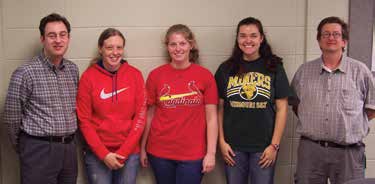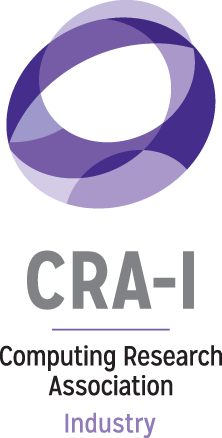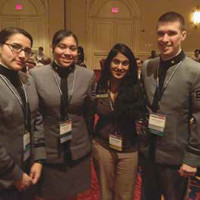Happy Birthday, CREU!
by Andrea Danyluk
Originally Printed in the Summer/Fall 2013 Newsletter
The Collaborative Research Experience for Undergraduates (CREU) program is 15 years old. – It’s seen some changes as it’s grown. – Its name, for instance, has morphed from CREW to CREU. – Much more importantly, it is now a joint project of CRA-W and the Coalition to Diversify Computing (CDC).

Members of the CREU team from Missouri University of Science and Technol-ogy (faculty mentor Matt Insall, Chelsea Sanders, Kathleen Venhaus, Tiffany Werckmann, and faculty mentor Daniel Tauritz)
But amid these and other changes, three key components – collaboration, cohort, and terrific mentoring – remain at the heart of the program.
CREU encourages and supports undergraduate women and minorities in computing research. – The goal of the program is to increase the number of women and minorities who continue on to graduate school in computer science and computer engineering. – Teams of undergraduates work with faculty member sponsors at their home institutions on research projects during the academic year and, in some cases, the following summer. The ability to work on the project through an entire academic year provides a complete research experience that can be more difficult to achieve in a shorter period of time. CREU students receive stipends for their work. This acknowledges the research as an important contribution to computer science and, of course, the students themselves.
Collaboration: Becoming a Member of a Research Team
Research shows that peer support can have significant impact on persistence in computer science education and in particular that women benefit from having a critical mass of female colleagues. – So the CREU program emphasizes collaboration in the form of small (typically 2-4 students) teams.
Students in CREU projects tend to already know their advisors and each other. – This level of familiarity from the start, together with regular meetings, collaboration, and an overall shared sense of purpose makes it possible for the students to build strong relationships with each other and to have a strong sense of belonging to a research community. – It also provides a natural way for students to learn that a group can be much stronger than the sum of the individuals in it.
As one CREU student put it, “We’re all from completely different backgrounds and think about computer science in completely different ways […] It turns out that this is actually our strength. – […] Instead of clashing we help each other and when we encounter things that nobody knows we work together to figure it out.”
Cohort: Becoming a Member of the Wider Research Community
Students participating in CREU are strongly encouraged to submit papers to journals and to present papers or posters at national or regional conferences. – The program provides travel funds to support such participation. CREU participants find that having the opportunity to participate in the wider research community is both exciting and empowering.
In the past year alone, CREU students have been co-authors on papers presented at a wide and impressive array of venues, including the USENIX conference on File and Storage Technologies (FAST 2013), the ACM Conference on Human Factors in Computing Systems (CHI ’13), and the ACM Technical Symposium on Computer Science Education (SIGCSE 2013).
Fourteen CREU posters were presented at the Grace Hopper Celebration of Women in Computing 2012, which was the official cohort meeting place for CREU 2011-12 students. – Ten CREU students attended or presented posters at the Tapia Celebration of Diversity in Computing 2013.
Mentoring for Success
It’s hard to say enough about the importance of good mentoring. – From devising a good project to guiding the work to providing advice on careers, the mentor is a critical component of each CREU project.
Mentoring begins in the proposal phase, with the advisor crafting a great project and involving the students in the writing of the proposal. – It can be a real challenge to design a project that is truly a research experience (i.e., that doesn’t have a known outcome or solution), requires only the skills and experience that an undergraduate can reasonably be expected to have, and also has a good probability of success in a one-year time frame. – CREU mentors have a terrific sense of just the right level of difficult but doable.
CREU participants work closely with their faculty mentors and sometimes additionally with post-docs and graduate students. Some mentors work side-by-side with students in the lab. – Others schedule weekly group meetings to review the students’ progress and set goals for the next week. – Through this close interaction, CREU mentors keep their students moving forward. – As one student put it, her mentor was “great about guiding us through difficulties, making sure we have the resources we need and helping us stay on track.”
Informal interactions between students and mentors can be just as important as formal meetings. – CREU students note and appreciate these interactions. – “By working on this project, I am learning a lot about a career in academia and about graduate school and the field in general. – I am really glad that through this project, I have learned a lot more about this field and not just about the project that I am working on.” – We expect that CREU mentors will take a genuine interest in the professional development of their students and will talk to them about their career ambitions, about being a researcher, applying to graduate school and so on.
Finally, CREU mentors serve as role models. – In addition to “trying out” research for themselves, the students observe real researchers – their mentors – at work.
How to Get Involved in a CREU Project?
An application to the CREU program consists of a research proposal. – The proposal should contain a project description, the specific questions to be addressed or hypotheses to
be investigated, the plan and methods for carrying out the research, and a summary of related work on the topic along with appropriate citations. – In addition, the proposal should describe the student and faculty responsibilities and the timeline.
The proposal is also the means by which the CREU program gets to know the students who would be involved in the project, and so the proposal should include relevant information about the students, such as their transcripts and explanations of the ways in which the CREU project would provide a meaningful experience for them. – For more information on CREU.






